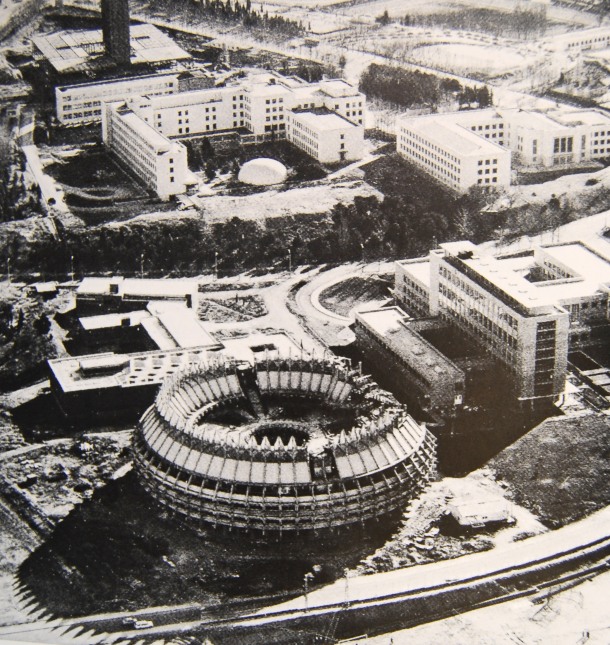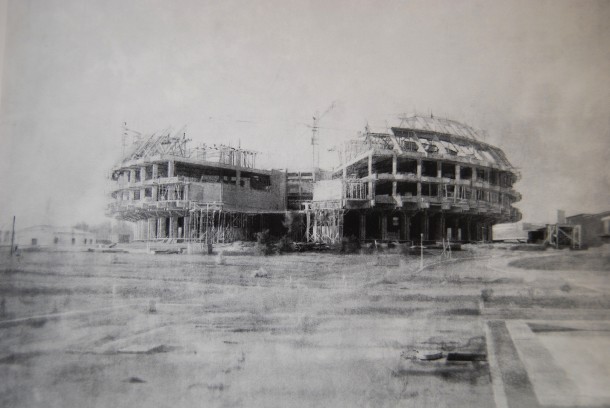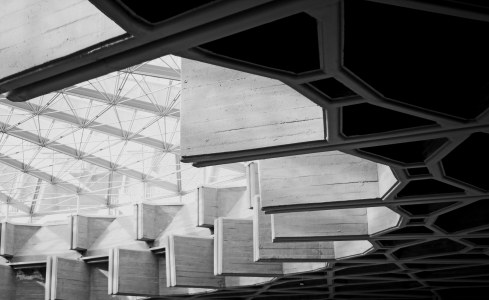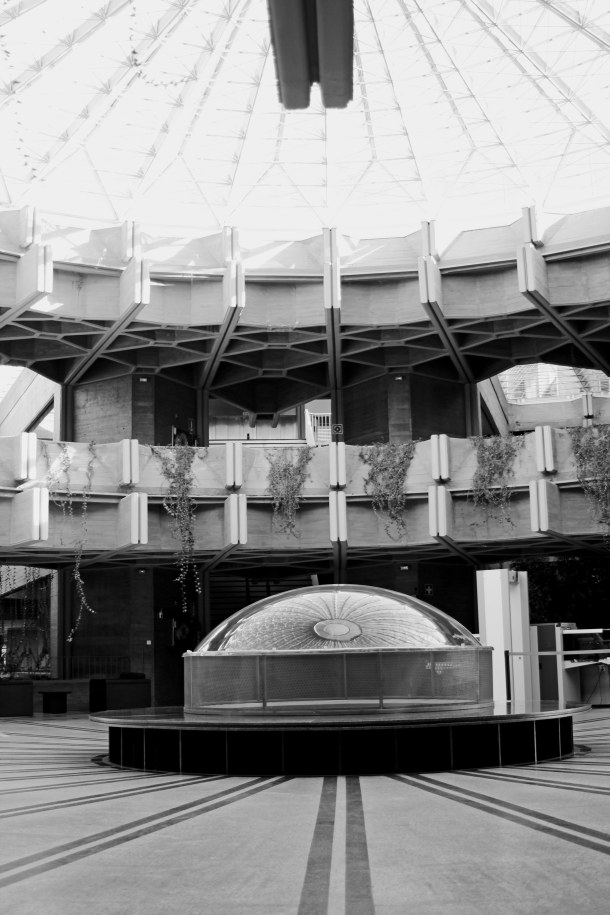If you love concrete you’ll love this piece, built between 1960-1990. The Spanish cultural heritage building, “Instituto del Patrimonio Cultural” is the most unusual concrete building in Madrid.
Building: Instituto del Patrimonio Cultural de España
Architects: Fernando Higueras (1930-2008), Rafael Moneo (1937- ), Antonio Miró (1931-2011)
Year built: 1960-1990
Location: Calle del Greco, 4 (Madrid)
 IPC, Faculty of Fine Arts, Faculties of Architecture (ETSAM and ETSEM)
IPC, Faculty of Fine Arts, Faculties of Architecture (ETSAM and ETSEM)
WHAT IS IT: The project of the Headquarters of the Cultural Heritage of Spain (Instituto del Patrimonio Cultural de España) was won in a competition by architects Fernando Higueras and Rafael Moneo (making them the winners of the National Prize of Architecture in Spain too). The program, “An artistic restoration center” was organized in a circular building layout. However, the design changed over the years.
Construction started in 1967 but it took several years until it got finished. In 1970, 4 months before its completion day, construction stopped leaving it unfinished for a long time. And it wasn’t until 1990 that the building completed its construction.
 Famous drawing by Antonio López
Famous drawing by Antonio López
PLANS: Its form changed over the years. The original design was composed by a pyramid but the built design was the result of inverting the voids. The building’s form is a 40m radius circle divided into 30 sections and 56 frames. It has 4 storeys which have a big courtyard in the middle plus 5 inner courtyards with interior gardens.
ARCHITECT AND ARCHITECTURE:So you’ll wonder what this piece of naked architecture is doing here. The IPC is a stranger to the rationalist architecture of its environment (surrounded by The Fine Arts building and the two Faculties of Architecture). This building was a result of the main architect’s obsession.
He claimed he was anti-Le Corbusier and anti-Mies stating -“More is more“-
He was obsessed with the logic of construction, he was obsessed with biomorphism and the raw beauty in depth and light. Most of his buildings were therefore made in reinforced concrete.
 Fernando Higueras on the front
Fernando Higueras on the front
CONCEPT: His architecture could be described as an obsession of the following factors:
- Simple spatial distributions: Clear circulations, functionality
- Composition: Construction and form get together in its geometry.
- Repetition: Rhythm in the structure
- Symmetry: By having an axis
- Circles: Either in form, in structure
- Center: Which works as the core of the building
- Zenithal light: That comes trough the space vertically
- Vegetation: Inside and outside the building avoiding limits.
- Balconies: Hierarchy
- Monumentality: Provided by geometrical forms and materials (always pure).
MATERIALS + DETAILS: Tectonically, the building is conceived as one whole. It is made of reinforced concrete without any interior additions, which saved money. It has two cores of stairs and elevators.
INTERIORS: The interiors are very impressive. It’s hard to distinguish were the exterior begins due to the light and use of vegetation. Spaces are monumental due to the floor to ceiling height and the lack of ornament in the walls.
In conclusion, no matter how isolated it looks from its exterior, interior spaces are fluent, open and full of light. A new concept of circulations is possible due to its circular form and lack of closed spaces. Windows and other separation devices have been added recently because water from the gardens came in the working spaces, but that doesn’t interrupt the visual continuity inside the building. Definitely, this is one of the most significant concrete buildings in the Spanish capital.
 What did you think of the building? Would you enjoy working here?
What did you think of the building? Would you enjoy working here?
Discover more amazing architecture of Madrid on the map below or download my Free Architecture Guide of Madrid.
Pictures: Javier F. Escribano, Virginia Duran
Bibliography: “La corona de espinas Instituto del Patrimonio Cultural de España 1960-1990″ by Alberto Humanes
ISBN: 978-84-921038-9-8
You may also like 50+ Architectural Reasons to Visit Every Province in Spain (1/2)


















Extraordinary! I am not sure what to make of it. The courtyards and the light seem lovely. Have you been inside it?
LikeLike
Yes, I visited it last week for the first time, although it’s a 5 min walk from the School of Architecture where I go every week. The day I visited it was very sunny and the interior light was fascinating to be honest. As there are barely no partition walls light goes from the windows to nearly the other side of the corridor. The only thing that didn’t seem to work was the temperature. Since it has the same form on every angle, some areas are too cold in winter and too warm in summer. Apparently the blinds didn’t protect the building enough. I did a thousand pictures (even the bathrooms haha) so if you think I missed some important information I coud add more photographs!
LikeLike
I wondered how the temperature control would work! And I am always interested in bathrooms; often a much neglected aspect of a building 🙂
LikeLike
The joy for me is the creative use of the material. It’s always stunned me that (especially in America) there is such bland use of concrete. Of course, Frank Lloyd Wright changed it all. Wish that I could explore the space. Thanks for this post.
LikeLike
Sometimes the use of certain materials is a matter of fashion. It’s true that Frank Lloyd Wright used concrete, however, he always put ornament over the materials (concrete, brick etc.). This tendency in leaving the raw material exposed is actually something recent (last 20-30 years). You should visit Madrid some time anyways :))
Are there any concrete buildings close to your area, I bet so!
LikeLike
What a strange fascinating building. I kind of like it because it is so darned different. I would love to see it firsthand. It’s not grotesque or offensive or bland…It’s definitely one of a kind. 🙂
LikeLike
If you visit Madrid you’ll definitely have to see this building, it’s very close to the city center actually. The way you describe it makes me think of the Prentice Women’s Hospital (which is under demolition right now) in Chicago. I always went by and wondered what it was. Do you remember that building?
LikeLike
Yes! In Streeterville?
LikeLike
Mmm…here 250 E Superior St. but it’s no longer there. I loved the building http://bertrandgoldberg.org/projects/prentice-women%E2%80%99s-hospital/
LikeLike
The preservationists lost out against Northwestern. The shiny building that is supposed to replace it will seem quite boring by comparison.
It’s a real shame the building couldn’t have been redeveloped in some way.
LikeLike
Aaaargh! Can’t believe this is true. I saw other project proposals that preserved in some way the form and the concept of the original hospital but this is a completely different building. It’s really shocking to me how the government doesn’t try to preserve this type of architecture. In Italy nothing new gets built… in Chicago everything gets demolished. Well I’ll be back in Chicago in a couple of months so I’ll get to see how construction goes.
LikeLike
You captured it all Virginia. Thanks for a great post.
LikeLike
Your comments are always nice!
Thanks so much for stopping by 🙂
LikeLike
A bit of the poetic Brutalism
LikeLike
Sometimes that is all about concrete, isn’t it?
LikeLike
interesting building. Somehow I missed this on my travels through spain 😦
LikeLike
Oh! You’ll have to return. There are so many hidden buildings in Madrid… but if you come back you can now visit 🙂
LikeLike
It looks like the ‘mother-ship’ to me! But obviously, of *friendly* aliens, since they arrived bearing a library!!! Cool and quirky.
LikeLike
hahaha this comment made me smile 🙂 It looks like military architecture in a way – mother ship too. But the interior is indeed friendly.
Have you ever visited Madrid?
LikeLike
Not yet, but it’s long been on my list of hoped-for destinations!
LikeLike
You should definitely, spring is the best time because in summer it gets extremely warm. If you visit Spain in summer you’d rather go to Barcelona 🙂
LikeLike
I am really ignorant as far as architecture is concerned… I love your detailed posts and explanations though… they make me feel like I have the right to have a solid opinion! I love this building for example but I wouldn’t be able to say why without your post… Now, I think it is because I love concrete (in general) and because the light seems to have been managed particularly well in this structure! Thanks for sharing your knowledge with us… it’s really precious and relaxing to read you!
LikeLike
Thanks for your kind words 🙂 You do have the right to have an opinion even if you haven’t visited the buildings. Sometimes we don’t like a certain building, for no reason. However, I am happy that you liked this one, at least by the pictures in the post (it’s even more amazing I promiss). So if you ever come back to Madrid you should visit 🙂
Love your new web by the way. It seems your project is going forward! Congratulations 😉
LikeLike
Thanks Virginia… yes I’m done with the technical stuff and I’m ready for real information and knowledge exchange now!
LikeLike
Hello again Virginia,
I sent my son, who is an architect, the link to this post. He enjoyed it tremendously.
In return, he sent me a link to his favorite library. It follows:
http://www.erikgunnarasplund.com/eng/gallery7-stockholmsstadsbibliotek.asp
Thank you for your great posts.
Wally
LikeLike
Hola Virginia,
soy estudiante de arquitectura en la Universidad de Navarra. Estoy haciendo un trabajo sobre la morfología estructural del IPC y he llegado a tu blog.
Me parece una entrada muy buena y me preguntaba si podría usar las imágenes de los planos así como los detalles de la escalera y el lucernario.
Si pudiera obtener las imágenes en buena resolución me harías un gran favor, tanto si me las puedes enviar por email o diciéndome si están disponibles en internet.
Muchas gracias de todas formas,
Guillermo
LikeLike
Thanks so much for sharing this! I just went to see this building and it looks amazing from outside. But I can’t go inside because I have no time to apply for the visit ( only stay here for few days) I m wondering do u have more pictures of the building and where do u get the construction plans?
Looking forwards to ur reply!
Many thanks
Iris
LikeLike
Hello Iris,
Glad you liked the building, it’s one of my favorites. I have more pictures of it from my last visit, do you need any in particular? Also, the construction plans of the final building are inexistent because it was built differently from the original plans (which are the ones in this article). But maybe there are “unofficial” plans out there that somebody drew. For what do you need them? Maybe I can help!
LikeLike
Thanks for the reply!
I want some images of the interiors(any related to the construction and maybe roof? View from balcony? If u have some, it would be sooo great!) I am doing an architectural project atm, might use some of them( I will write the reference:))
About the construction plan, yeah I m curious about the scale as the characters on the image is not very clear.
Do u have any ideas about how to find research about this building on books?
Many thanks!!
Iris
LikeLike
You can find the book I recommended at the Architecture school (ETSAM) closeby to this building. There weren’t so many books about it, but that one was very helpful.
On the other hand, will get back to you soon (to your email) regarding the pictures.
Kind regards,
Virginia
LikeLike
Thanks so much for sharing it! I just went to see the building. It looks amazing!
But I m not be able to go inside T^T
Do u have more pictures of the building?
Btw, where do u get the research(the historical image and the construction plans)?
Looking forward to ur reply!
Many thanks
Iris
LikeLike
I have more pictures of the building but they are not online, let me know if you need a specific one.
The research is from “La corona de espinas Instituto del Patrimonio Cultural de España 1960-1990″ by Alberto Humanes
ISBN: 978-84-921038-9-8
LikeLike
Thank you soooo much! I will have a look at the book. Can’t wait to see the same pictures as well!
Many thanks
Iris
LikeLike
Thanks so much! I will have a look at the book. Can’t wait to see the pictures as well.
Kind regards
Iris
LikeLike
Pingback: The Free Architecture Guide of Madrid (PDF) | Virginia Duran
Pingback: 23 Spots You Shouldn’t Miss in Madrid If You Love Architecture | Virginia Duran